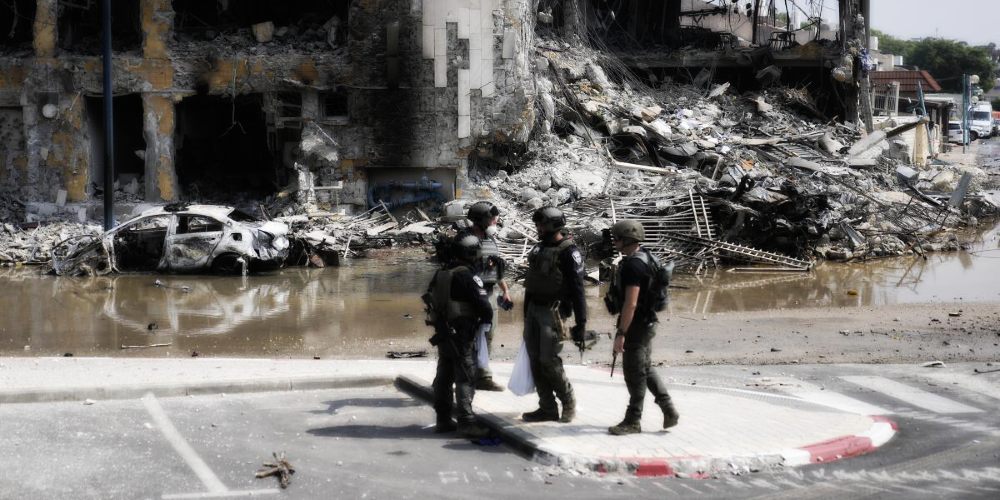- Gold SKYROCKETED during Trump’s first term and is poised to do it again. Find out how Genesis Precious Metals can help you secure your retirement with a proper self-directed IRA backed by physical precious metals.
- Israel’s planned ground operation to destroy Hamas in Gaza will be like “moving through a minefield,” experts told the Daily Caller News Foundation.
- The Israel Defense Forces will face a stronger enemy than previously engaged on urban battlefields, which are already dangerous and require specialized tactics.
- “If you hurry, you not only make more mistakes in terms of collateral damage, civilian deaths, material destruction, but you also take more friendly casualties as well,” Michael Knights, a researcher at the Washington Institute for Near East Policy (WINEP), told the DCNF.
![]() (Daily Caller)—Israel is preparing to invade Gaza, a task that will require its military to engage in grinding warfare through an urban setting and defeat a Hamas organization that is stronger than ever, experts told the Daily Caller News Foundation.
(Daily Caller)—Israel is preparing to invade Gaza, a task that will require its military to engage in grinding warfare through an urban setting and defeat a Hamas organization that is stronger than ever, experts told the Daily Caller News Foundation.
Israel’s objective is to wipe out all remnants of the Iran-backed terrorist organization whose members brutally murdered 1,300 Israelis, mostly civilians, in an unanticipated intrusion on Oct. 7, Israel’s leaders say. While the Israel Defense Forces (IDF) is better armed than Hamas and has trained for exactly the kind of operation it plans to execute in Gaza, the coming fight will present new challenges it has not yet dealt with in combat, experts said.
Michael Knights, a researcher at the Washington Institute for Near East Policy (WINEP), explained the challenges the IDF will face before achieving its war aims. Gaza is packed with secretive tunnels, deteriorating buildings that can be used as strongpoints for attack and thousands of “fanatical” fighters, he said, not to mention civilians.
“Any environment like this — ruins, dents, building quality, lots of civilians— it’s complicated. Then you’ve got hostages, then the three dimensional component [of] tall buildings and really extensive underground spaces,” Knights said. “And then you’ve got an enemy that is probably more advanced than anything we’re seeing outside of the Ukraine environment.”
Hamas is a “fanatical defending force that is actually very well armed,” Knights told the DCNF.
The operation will be like “moving through a minefield” while under fire the entire way through the city, he said.
Hamas mostly controls the 140-square-mile strip of land between Israel and the Mediterranean Sea and for years has used it as a base from which to pummel Israel with rockets.
The organization is highly proficient by the standards of paramilitary organizations, in large part because it receives funding, training, weapons and technical support from Iran, Knights and others explained.
Hamas also boasts a relatively large arsenal of attack drones, rockets and the most advanced anti-armor weapon available to any military, Knights told the DCNF.
Israeli intelligence estimated in 2021 Hamas and other Palestinian militant groups maintained a stockpile of about 30,000 rockets, The New York Times reported. That includes a mix of crudely-made, inaccurate Qassam rockets and more advanced missiles and components components smuggled in from Iran and Syria. But, so far, there is no evidence Hamas has guided surface-to-surface missiles, Fabian Hinz wrote in the International Institute of Strategic Studies.
The terrorist organization fired as many as 2,500 rockets on the first day of the war, according to Hinz — Hamas claimed a number closer to 5,000.
Israel believes Hamas has around 30,000 fighters who will be willing to give their lives resisting the IDF, according to The Associated Press. However, it will also leverage civilians as shields to prevent Israel from striking at Hamas positions or members for fear of killing noncombatants, a war crime, John Spencer, chair of urban warfare studies at West Point’s Modern War Institute, wrote. The IDF called for Gazans to evacuate, but nevertheless many will likely remain.
Hamas’ incursion on Oct. 7 showed that the group has “reached new levels of organizational capability” since it last clashed with the IDF in Gaza, Seth Frantzman, an adjunct fellow at the Foundation for Defense of Democracies, told the DCNF. “It’s weapons are still primarily older AK-47s and RPGs, but it also now has small quadcopter drones and many types of mines and explosives that it can use to booby-trap areas.”
“The real challenge will be fighting in an urban area where there are civilians,” Frantzman said.
Gaza City itself comprises about 20 square miles, and Gaza has a handful of other 5-square-mile urban areas, according to WINEP. However, Gaza is far more densely populated than other urban battlefields of recent wars, such as Raqqa in Syria or Mosul in Iraq.
Comparing Israel’s imminent fight in Gaza to those of Mosul and Raqqa provides limited context. Gaza is more built-up than either of the reference cities and pierced with an extensive network of underground tunnels Hamas, adding an unknown dimension to battlefield space and tactical considerations, WINEP said.
Tunnels can hide weapons depots and fighting positions, potentially for launching ambushes, according to The Economist. Hamas can use the tunnels to relay messages undetected and move rockets from one point in the city to another. The tunnels afford critical protection from Israeli airstrikes.
“In 2008, the air strike and air surveillance [by Israel] took us by surprise … so we made strategic plans to move the battle from the surface to underground,” a Hamas commander said, referring to Israel’s 22-day operation in Gaza, The Economist reported.
In 2014, the IDF launched an operation to degrade the tunnel network, destroying 32 of an estimated 1,300, according to The Economist. A post-operation inquiry found that the IDF was unprepared for the challenges of first locating, then destroying, the tunnels.
An estimated 300 miles of tunnel infrastructure snakes through Gaza and possibly into Israel, according to a 2021 estimate, NPR reported. Many of them are narrow, deep underground and traversing underneath major civilian sites like hospitals or mosques. Hamas is able to use foreign support and capital investment to rebuild tunnels and construct new ones.
While the Islamic State had two years to construct defenses in Mosul and Raqqa, Hamas has been working on Gaza’s defensive infrastructure for 15 years, according to WINEP. IDF forces will have to destroy overhead and ground fortifications and artillery emplacements while also navigating anti-personnel and anti-armor minefields, hidden IEDs and booby-trapped buildings.
At the same time, the IDF benefits from an encyclopedia of knowledge compiled over years of constantly surveilling Gaza, as well as two prior wars in the territory from which to draw insight.
“The IDF appears to be the most cohesive, well-equipped, and well-prepared force to fight major urban battles since the U.S. military itself fought the highly destructive second Battle of Fallujah in November 2004,” Knights wrote.
The Israel Defense Forces mobilized some 300,000 reservists to supplement its roughly 170,000 active duty troops, effectively tripling manpower available for the fight.
Israeli defense minister Yoav Gallant pledged to “wipe out” Hamas “from the face of the earth” on Oct. 12, day 5 of the conflict, while standing alongside other members of Israel’s newly-formed war cabinet, Times of Israel reported. In the days since, the defense minister laid out specific war objectives and the broad outlines of a three-phase campaign.
The first phase has begun consisting of a “a military campaign by fire and later by tactical maneuver, the purpose of which will be to assassinate operatives and damage infrastructure” to destroy Hamas, Gallant said on Friday, Haaretz reported.
The second phase will involve lower-intensity combat to “eliminate pockets of resistance,” Gallant said, Times of Israel reported. In the final step, Israel plans to create “a new security regime in the Gaza Strip” and for Israel, eliminating any Israeli responsibility for Gaza’s day-to-day welfare.
Gallant told troops stationed near the border with Gaza a ground operation would come “soon,” Times of Israel reported. He warned the fight will be long, difficult and intense.
IDF spokesperson Daniel Hagari said the Israeli Air Force was firing on Gaza “at a rate not seen in decades” to prepare the battlefield for a ground invasion, Haaretz reported.
“The IDF has trained for this, but the reality of this kind of warfare is always more difficult than the training,” Frantzman told the DCNF.
Knights explained the ground operation as “nibbling away” at bits of the city. First the IDF identifies a block or avenue it wants to control, then spends a couple of hours probing it and “pulverizing” areas that respond with gunfire. Then troops move in to secure the area.
“Then you look at the next slice, and you do it again. And you do that 30, 50, 70 or 120 times until you’ve got the whole area” and ideally handing responsibility for those areas off to a multinational forces and observance organization, Knights said. The IDF will be able to commit a handful of troops at any one time to frontline slivers for 24 to 48 hours, ensuring troops maintain fresh and minimizing the numbers of casualties any one unit sustains, he explained.
It will take months at minimum to secure the entire city.
“If you hurry, you not only make more mistakes in terms of collateral damage, civilian deaths, material destruction, but you also take more friendly casualties as well,” Knights said.
“And if you’re working somebody else’s timeline, like how long the U.S. can hold international pressure at bay or something along those lines, then you tend to make more mistakes,” Knights said.
All content created by the Daily Caller News Foundation, an independent and nonpartisan newswire service, is available without charge to any legitimate news publisher that can provide a large audience. All republished articles must include our logo, our reporter’s byline and their DCNF affiliation. For any questions about our guidelines or partnering with us, please contact licensing@dailycallernewsfoundation.org.




